88-Years-Young, Manipur Grandma Keeps Potloi Alive, Dresses 1,000+ Brides in 58 Yrs
“I may not live long now but I want the art of Potloi-making to live on. I hope that the skills that I have imparted make beautiful designs of Potloi,” says Abok Radhe.
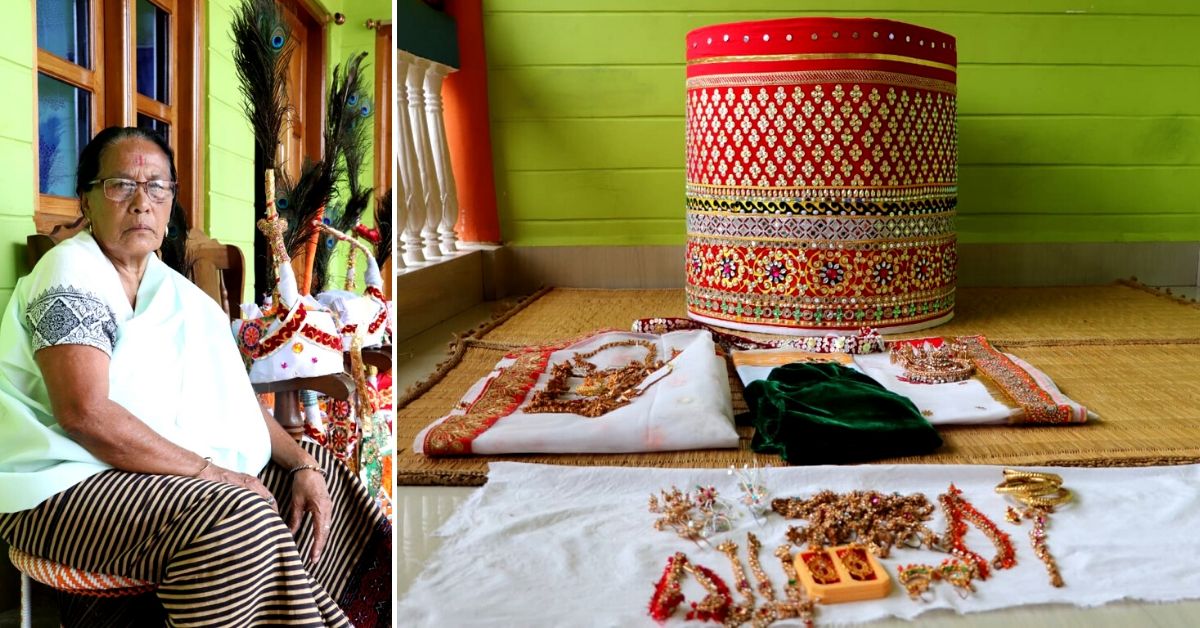
With The Positive Collective, The Better India’s COVID-19 coverage is available to regional language publications for free. Write to [email protected] for more details.
Radhe Devi sits in the middle of the verandah of her home with a piece of cloth in her hand. Around her are ribbons, stones, and mirrors that she carefully sews on the cloth. Spectacles perched on her nose, her eyes are focused in concentration–the cloth she is working on will be transformed into a skirt that forms an important part of the Manipuri wedding attire known as ‘Potloi’.
The 88-year-old is lovingly called ‘Abok Radhe’ (where Abok means ‘grandma’ in the Meitei language). Since the past 58 years, she has been working as a ‘Potloi Setpi’ (wedding dresser)! The octogenarian entrepreneur, based out of the Thoubal district in Manipur, has dressed over 1,000+ brides in her lifetime.

“Every time I design the Potloi for a bride, I get very anxious. I ask myself if they will like it and if it will make them happy. And when I see a happy bride walk down during the ceremony and people gush over the handiwork, it gives me joy. When they ask who made it, I feel proud of myself,” says the grandma.
The Potloi comprises the stiff cylindrical skirt, a blouse, a woven belt around the waist, and Innaphi, which is a delicate muslin shawl wrapped around the upper body. Abok Radhe also matches her outfit with local jewellery before she presents it to the bride.
Even now, Abok is unstoppable! She can make an entire outfit in merely five to seven days!
In addition to this, she also makes costumes for the Khamba-Thoibi dance, which is based on a popular Manipuri legend.
When the wedding season is over, Abok also makes dolls using cloth and rice straws, and sells them in local shops.
The effervescent bridal wear designer shares her entrepreneurial journey, proving that age is just a number!
From a mum to a Potloi entrepreneur

“I was only 15-years-old when I got married,” informs Abok, from her home in Wangjing Sorokhaibam Leikai. Abok Radhe had seven children and was a homemaker. Her husband, late Hanjabam Mani Sharma, was an astrologer and would participate in important activities in the temple.
So, how did she learn the art of Potloi making?
“When I was 25-years-old, a lady in my neighbourhood was involved in the art of Potloi making. She was like a sister to me, and hence, I would often help her finish her orders. This is how I first learnt the different processes involved in making the wedding garments,” she says.
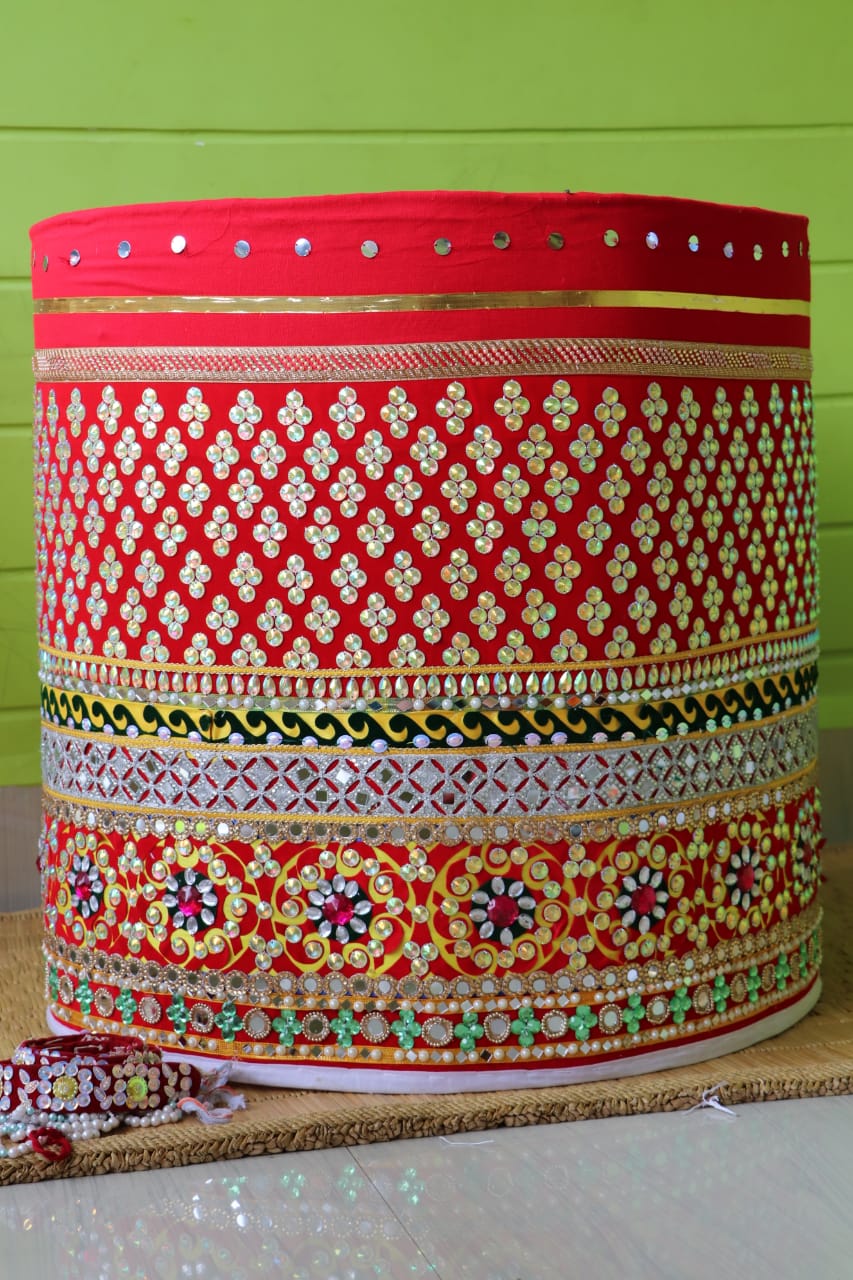
However, it was when she turned 30 that she got into making the outfits on her own.
“My daughter, who was only seven years old at the time, was taking part in the local Ras Leela drama. In those days, no shop or costume designer sold the costumes. So, I had to design a dress for my daughter,” recalls Abok Radhe.
She designed her daughter’s costume in merely five days! This made her confident enough to pursue dressmaking as a profession. At that point, her family was not doing too well, and she wanted to contribute financially.
To refine her handiwork, Abok Radhe trained under Khurailakpam Iboton Sharma. This man was multi-talented as he was a dance teacher, who was involved in local theatre, and was also a dress designer.
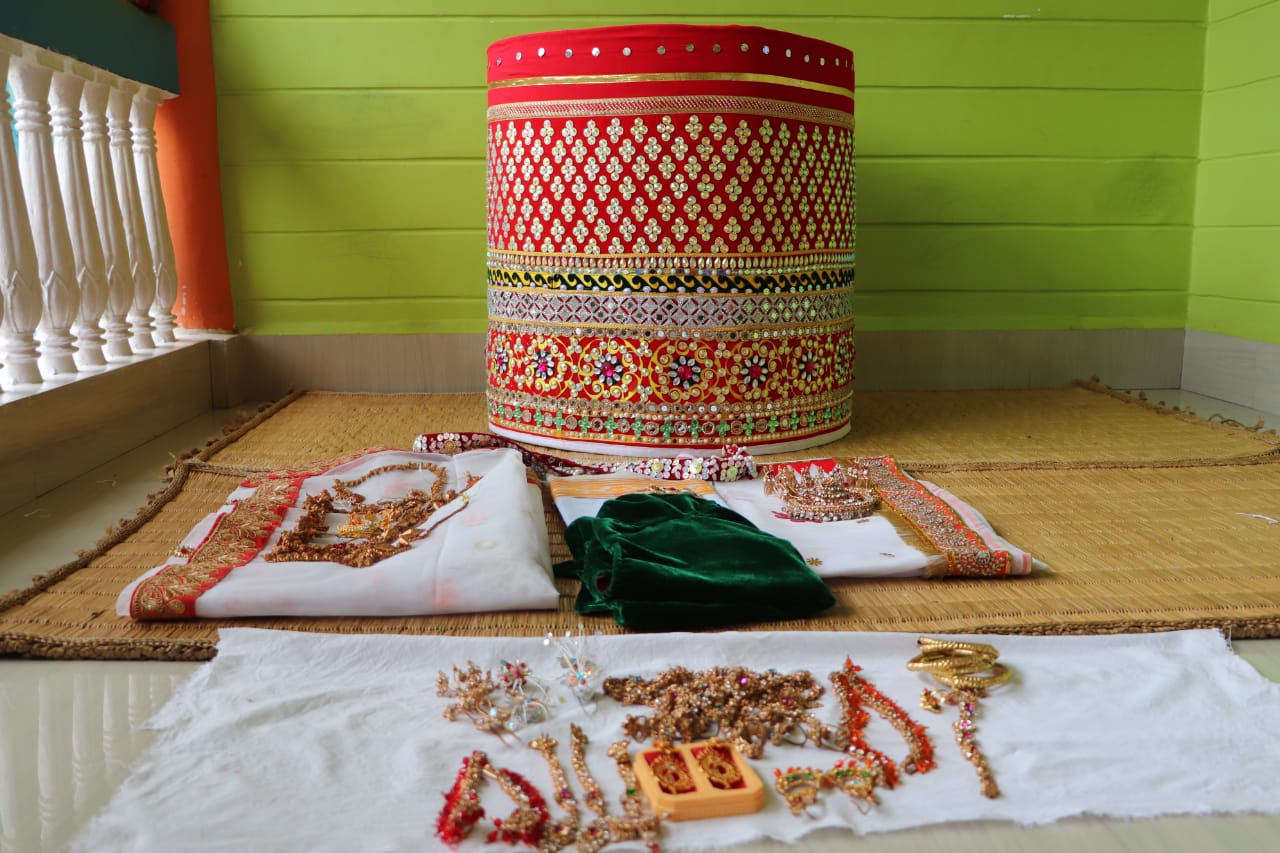
In fact, if one were to look at the history and origin of Potloi, it had its roots in the Ras Leela. The Potloi was introduced as a costume by Meidingu Chinthang Khoma or Maharaja Bhagyachandra (1749-1798), who composed three forms of Rasa Leela–Kunja Ras, Maha Ras and Basanta Ras–dedicated to Lord Krishna. The Potloi was the costume worn by Gopis in the Rasa Leela dance, and later, it became popular as a wedding outfit for brides during the Hindu-Meitei ceremonies.
Initially, when Abok started making outfits, she would take almost 15 days to make a set. The reason why she took so long was perfecting the shape of the stiff cylindrical skirt.
“Now, when we make the skirt, there is a thin rubber sheet used by bridal designers to give the skirt a stiff shape. But this wasn’t available before. So, I would have to stitch nine layers of cloth on the inner side of the embellished skirt. This would take a lot of time. Also, to make the skirt stiff, it had to be washed with rice starch and dried in the sun. When there would be no sunlight, it would spoil the outfit as it would end up rotting,” recalls Abok Radhe.
The Potloi comes in vibrant colours like red, pink, and green and is embellished with ribbons, stones, mirrors. The Innaphi too has beautiful borders that comprise small embellishments, ribbons, and embroidery.
When Abok started her small business of selling the Potloi, she would earn Rs 500 per outfit. Now, she sells each for anywhere between Rs 10,000-15,000 depending on the intricacy of the handiwork.
Other handiwork, challenges and looking forward

When the wedding season is over, Abok doesn’t stay idle. She makes dolls in tiny Potloi outfits in different sizes, and the price ranges from Rs 20-1.000 depending on the size and amount of handiwork.
In addition to that, she also makes costumes for the Khamba-Thoibi dance which is performed in the Lai Haraoba festival of the Meitei community, celebrated in May. This drama depicts the love story of a boy named Khamba, who belonged to the Khuman clan, and princess Thoibi, who belonged to the Moirang clan.
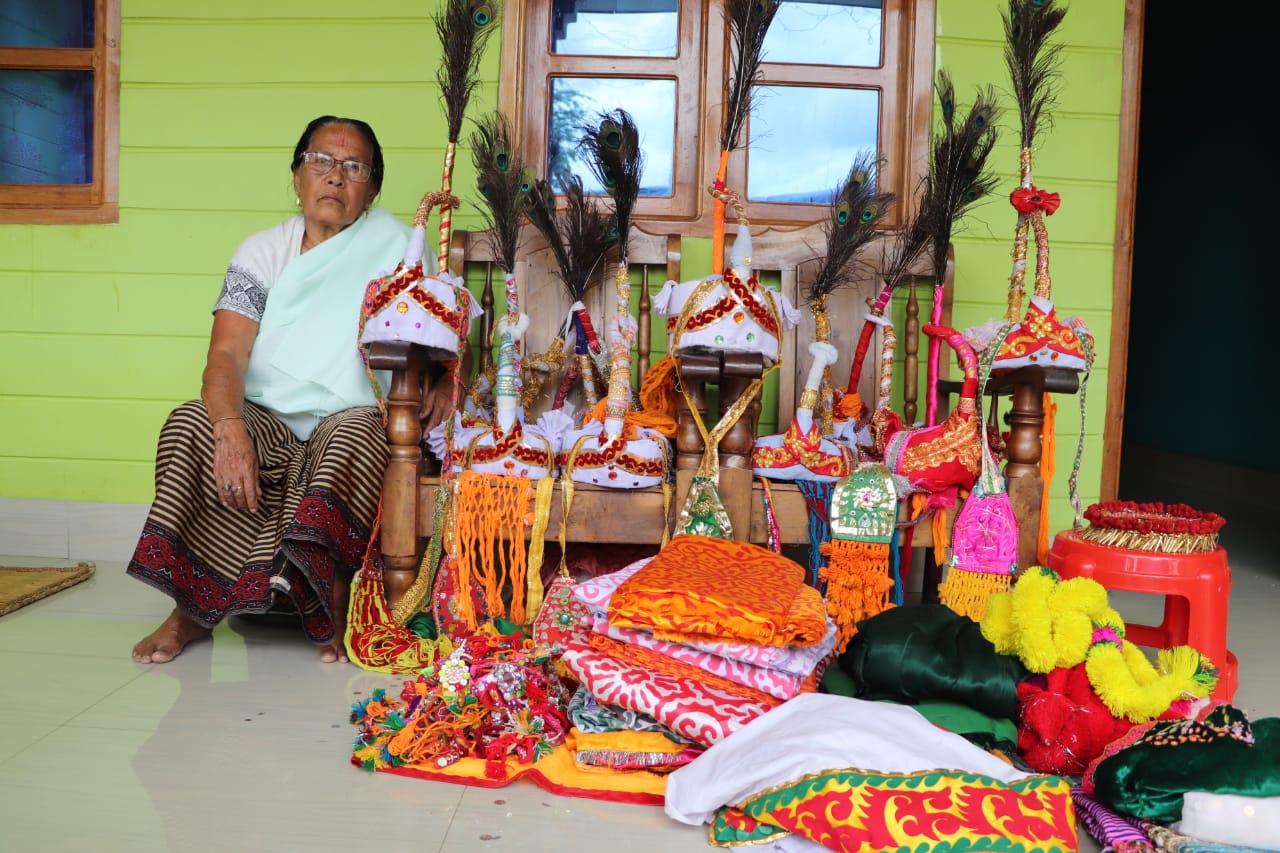
Here, the dress is elaborate. In addition to skirts made from printed cloth and handloom fabric, there is a top made from velvet, a thin muslin cloth tied around the waist, garlands, and elaborate headdress adorned with peacock feathers which draw the most focus. Abok makes these costumes as well.
However, while going about her business, Abok Radhe does face a few challenges.
“One of the key challenges is finding the right material for the Potloi outfits. As you might know, bandhs are a common phenomenon in Manipur. This affects the availability of rubber sheets and other materials, which are an integral part of the skirt. Without it, the skirt would not have the stiff cylindrical shape,” she says.
In her free time, Abok is also involved in social work; she is a prominent voice when it comes to women’s empowerment. She is associated with organisations like ‘Nupi Apunba Lup’ and ‘Ukalpan’, both based out of Wangjing, serving as their Secretary and Advisor.
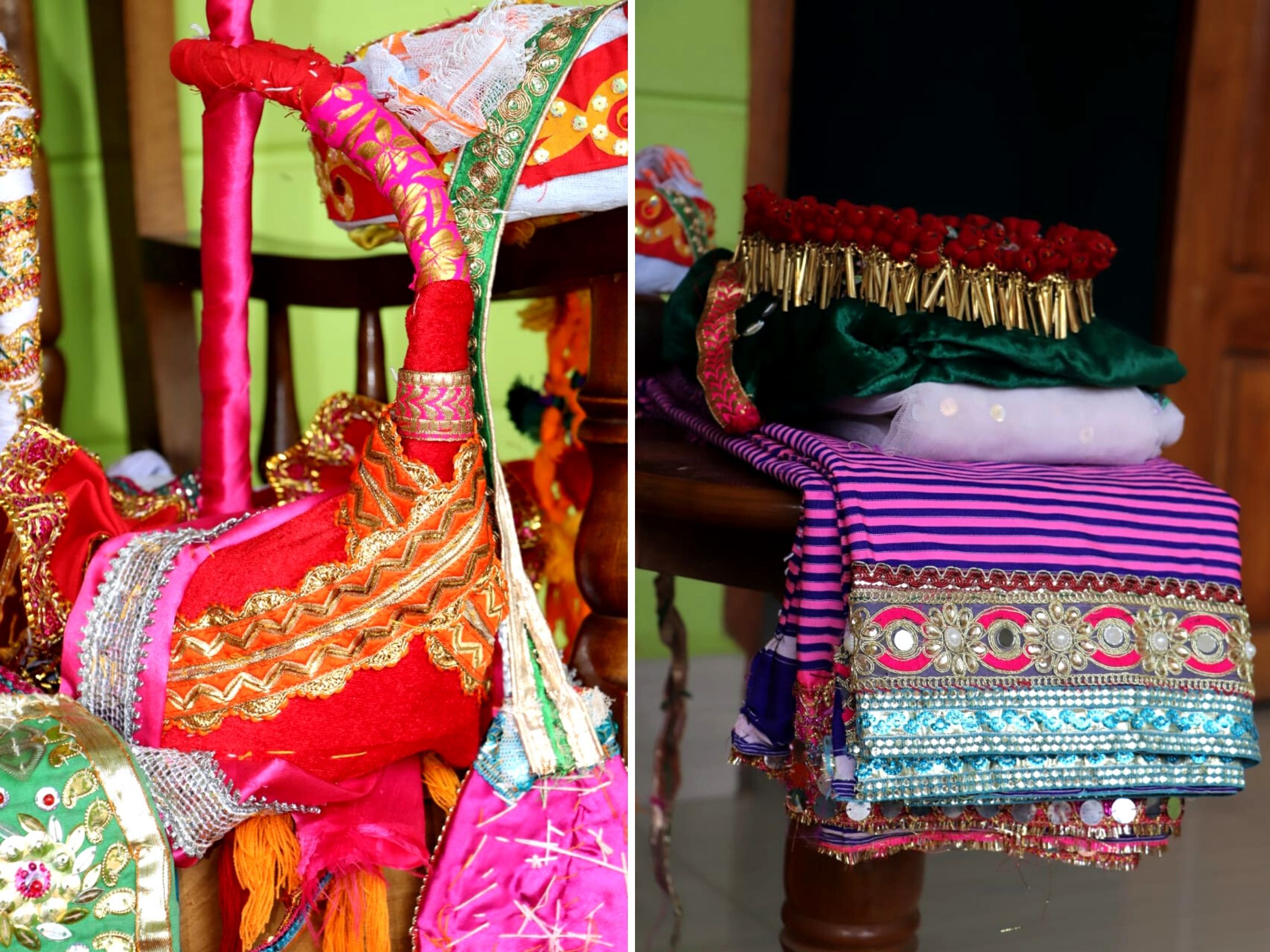
She also has created awareness on issues like drug addiction and women’s employment in the state. “I believe that it is important for a woman to be financially independent so that she can support herself in any situation and not depend on anyone,” she says.
Abok Radhe is well known for her Potloi work and a lot of students, especially women, come to her to learn the skill. Many of them have even gone ahead and started their businesses.
“I may not live long, but I want the art of Potloi-making to live on. I hope that the skills that I have imparted, help my students to make beautiful designs of Potloi. It is through my work and theirs that I want to be remembered,” says Abok Radhe signing off.
Images Courtesy: Nirupama Takhelchangbam
(Edited by Shruti Singhal)
Like this story? Or have something to share?
Write to us: [email protected]
Connect with us on Facebook and Twitter.
If you found our stories insightful, informative, or even just enjoyable, we invite you to consider making a voluntary payment to support the work we do at The Better India. Your contribution helps us continue producing quality content that educates, inspires, and drives positive change.
Choose one of the payment options below for your contribution-
By paying for the stories you value, you directly contribute to sustaining our efforts focused on making a difference in the world. Together, let’s ensure that impactful stories continue to be told and shared, enriching lives and communities alike.
Thank you for your support. Here are some frequently asked questions you might find helpful to know why you are contributing?


This story made me
- 97
- 121
- 89
- 167











